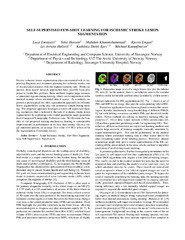Blar i forfatter "Hansen, Stine"
-
ADNet++: A few-shot learning framework for multi-class medical image volume segmentation with uncertainty-guided feature refinement
Hansen, Stine; Gautam, Srishti; Salahuddin, Suaiba Amina; Kampffmeyer, Michael Christian; Jenssen, Robert (Journal article; Tidsskriftartikkel, 2023-08-02)A major barrier to applying deep segmentation models in the medical domain is their typical data-hungry nature, requiring experts to collect and label large amounts of data for training. As a reaction, prototypical few-shot segmentation (FSS) models have recently gained traction as data-efficient alternatives. Nevertheless, despite the recent progress of these models, they still have some essential ... -
Anomaly detection-inspired few-shot medical image segmentation through self-supervision with supervoxels
Hansen, Stine; Gautam, Srishti; Jenssen, Robert; Kampffmeyer, Michael (Journal article; Tidsskriftartikkel; Peer reviewed, 2022-02-11)Recent work has shown that label-efficient few-shot learning through self-supervision can achieve promising medical image segmentation results. However, few-shot segmentation models typically rely on prototype representations of the semantic classes, resulting in a loss of local information that can degrade performance. This is particularly problematic for the typically large and highly heterogeneous ... -
Forest Health Monitoring by Detection of Biotic Agents in Satellite Images
Hansen, Stine (Master thesis; Mastergradsoppgave, 2018-06-01)Since 1999, the Pine Wood Nematode (PWN) has spread, infected and damaged growing areas of pine forest in Portugal. The pest is subject to strict quarantine measures, that require forest owners to register, fell and dispose of infected trees. As remote sensing from satellites provides repetitive and consistent data sets with high temporal resolution and large spatial coverage, a surveillance based ... -
Leveraging Supervoxels for Medical Image Volume Segmentation With Limited Supervision
Hansen, Stine (Doctoral thesis; Doktorgradsavhandling, 2022-12-16)The majority of existing methods for machine learning-based medical image segmentation are supervised models that require large amounts of fully annotated images. These types of datasets are typically not available in the medical domain and are difficult and expensive to generate. A wide-spread use of machine learning based models for medical image segmentation therefore requires the development of ... -
ProtoVAE: A Trustworthy Self-Explainable Prototypical Variational Model
Gautam, Srishti; Boubekki, Ahcene; Hansen, Stine; Salahuddin, Suaiba Amina; Jenssen, Robert; Hohne, Marina Marie-Claire; Kampffmeyer, Michael (Journal article; Tidsskriftartikkel; Peer reviewed, 2022-10-15)The need for interpretable models has fostered the development of self-explainable classifiers. Prior approaches are either based on multi-stage optimization schemes, impacting the predictive performance of the model, or produce explanations that are not transparent, trustworthy or do not capture the diversity of the data. To address these shortcomings, we propose ProtoVAE, a variational autoencoder-based ... -
A self-guided anomaly detection-inspired few-shot segmentation network
Salahuddin, Suaiba Amina; Hansen, Stine; Gautam, Srishti; Kampffmeyer, Michael; Jenssen, Robert (Journal article; Tidsskriftartikkel; Peer reviewed, 2022-11-13)Standard strategies for fully supervised semantic segmentation of medical images require large pixel-level annotated datasets. This makes such methods challenging due to the manual labor required and limits the usability when segmentation is needed for new classes for which data is scarce. Few-shot segmentation (FSS) is a recent and promising direction within the deep learning literature designed ... -
Self-Supervised Few-Shot Learning for Ischemic Stroke Lesion Segmentation
Tomasetti, Luca; Hansen, Stine; Khanmohammadi, Mahdieh; Engan, Kjersti; Høllesli, Liv Jorunn; Kurz, Kathinka Dæhli; Kampffmeyer, Michael Christian (Journal article; Tidsskriftartikkel; Peer reviewed, 2023-09-01)Precise ischemic lesion segmentation plays an essential role in improving diagnosis and treatment planning for ischemic stroke, one of the prevalent diseases with the highest mortality rate. While numerous deep neural network approaches have recently been proposed to tackle this problem, these methods require large amounts of annotated regions during training, which can be impractical in the medical ... -
This looks more like that: Enhancing Self-Explaining Models by Prototypical Relevance Propagation
Gautam, Srishti; Hohne, Marina Marie-Claire; Hansen, Stine; Jenssen, Robert; Kampffmeyer, Michael (Journal article; Tidsskriftartikkel; Peer reviewed, 2022-11-12)Current machine learning models have shown high efficiency in solving a wide variety of real-world problems. However, their black box character poses a major challenge for the comprehensibility and traceability of the underlying decision-making strategies. As a remedy, numerous post-hoc and self-explanation methods have been developed to interpret the models’ behavior. Those methods, in addition, ... -
Unsupervised supervoxel-based lung tumor segmentation across patient scans in hybrid PET/MRI
Hansen, Stine; Kuttner, Samuel; Kampffmeyer, Michael; Markussen, Tom-Vegard; Sundset, Rune; Øen, Silje Kjærnes; Eikenes, Live; Jenssen, Robert (Journal article; Tidsskriftartikkel; Peer reviewed, 2020-11-29)Tumor segmentation is a crucial but difficult task in treatment planning and follow-up of cancerous patients. The challenge of automating the tumor segmentation has recently received a lot of attention, but the potential of utilizing hybrid positron emission tomography (PET)/magnetic resonance imaging (MRI), a novel and promising imaging modality in oncology, is still under-explored. Recent ...


 English
English norsk
norsk







